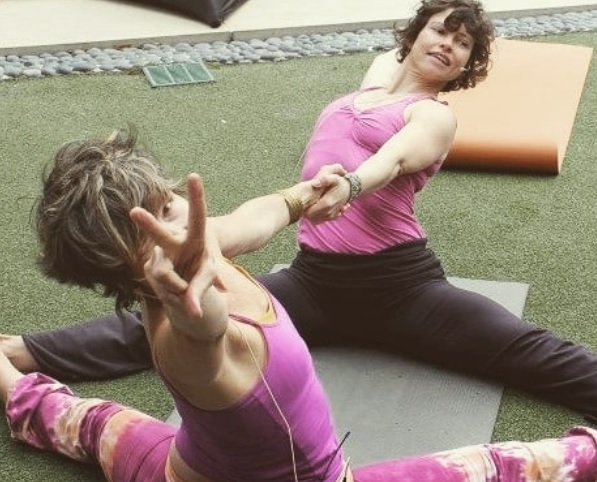For those of you unfamiliar with this practice, Partner Yoga is two or more people joining together to deepen the impact and experience of a yoga practice. The primary component that differentiates partner practice from individual practice is touch. We touch and are touched by others. We use traction and leverage, and the kinesthetic awareness that comes from touch, to open to greater depths in our bodies and our psyches.
Although Partner Yoga is a newly emerging practice, it has ancient roots in Tantric linages. Tantra, like Partner Yoga, is a word with many misconceptions, including that it is all about sex and for lovers only. The word Tantra however, essentially means to weave, and the core of its philosophy is using everything that we relate to as the part of the path. Partner Yoga also holds the philosophy of using relationship as a tool for awakening to our true nature.
As with any spiritual practice, there are many benefits we can receive from Partner Yoga. Along with a deepened self-awareness, we are also cultivating our ability to enter into and remain in relationships in ways that are healthy and beneficial. Our relationships are where we most easily experience the radical dichotomy we call heaven and hell. When weʼre in the heavenly realms and our relationships are flowing, life takes on a glow and we perceive everything through the eyes of love. On the contrary, when our relationships are strained, we often experience painful emotions that can be difficult to manage.
We experience this duality most profoundly in our intimate relationships, but it is true in all our connections- with parents, children, siblings, friends, society, even with Nature and the Divine. The desire to experience loving, vital, and healthy relationships is with us our entire lives. From birth to death, we are constantly learning about relating to others, although unfortunately, in our culture, we are given few tools or models to guide us. Yet despite our lack of skill in this area of our lives, there remains a deep yearning in each of us to experience love and acceptance in all of our relationships, including the one with ourselves.
What I have observed over my years of teaching Partner Yoga is this: we each have a particular tendency in our relational patterns. On one end of the spectrum, we may be so overly sensitive and yielding to others that we lose touch with a healthy boundary of self. At the other end, we may be so armored, emotionally and energetically, that we are unable to make an authentic connection with others. For some of us, it is a combination of both of these patterns or, we may vacillate between the two.
Partner Yoga practices help bring our relational patterns into balance. In our partner, we have a mirror, a physical presence that brings us into the present moment and paradoxically, more fully into ourselves. This presence supports us to integrate our insights into the very cells of our being, not just as an abstract mental concept, but as a fully embodied awareness. Just as in our relationships off the mat, in Partner Yoga we experience directly what it feels like to build trust, compassion, and intimacy with others. Our partners reflect back to us the qualities that we express. This is both the pleasure and the challenge of Partner Yoga, because we are also made acutely aware of those moments when we are shut down, distrustful, and unwilling to open and connect.
One of the foundational practices I introduce is Back to Back Sitting Meditation. The power and intimacy of this simple posture comes as quite a surprise to almost everyone who experiences it. Here are some general instructions for this practice:
Both partners sit in an easy crossed legged positions with sacrums firmly pressed together. Maintaining a strong sacral connection is the focus of this posture. To strengthen the sacral contact, both partners first lean forward, shift hips back until pelvic bones connect and then return to an upright position. Draw the lower abdomen up and to strengthen the sacral connection. Make sure you are not leaning against your partner, instead engage the natural curve of the lumbar spine to lift sternum. Allow shoulder blades to lightly graze your partner.
Direct the breath into the back body and allow the breath to release tension from the inner and outer body. Sense the distinction between awareness of yourself and awareness of your partner. Let go of all preconceived ideas concerning yourself and your partner and instead rest in the experience of your essential sameness. Notice the deepened self-awareness through conscious connection with another.<
For many of us, there is a belief that our endeavors (Yoga practice included) are simply easier to do on our own – we can avoid dealing with the needs and feelings of someone else. This thinking comes from the separate self/ego – the part of us that suffers the pain of loneliness while clinging to the illusion of independence. Partner Yoga practices unravel this illusion and reveal the beauty of our interdependence. We see that when we take the risk to become vulnerable in the presence of another, we are empowered to go much deeper with much less effort. This is also true in life. We can accomplish much more, with much more joy and ease when we (willingly) support each other.
Partner Yoga is not a substitute for individual practice. It is a practice that informs and strengthens our capacity in relationships, as well as our individual Yoga practice. Recently a student of Partner Yoga told me how she has learned more about her body and her individual practice through Partner Yoga than she had in all her individual Yoga training. Ideally, we learn to use each of these practices to inform the other.
Partner Yoga is a healing art that teaches the fundamental value of joining and sharing with others. It demonstrates how we become more authentic and empowered through our willingness to open and connect with the world around us. I’d like to emphasize that Partner Yoga is not for lovers only – it can be practiced by any two or more willing participants- friends, acquaintances, siblings, parents and children. Previous Yoga experience is not even required although it can be helpful for some of the more advanced practices.
The need for practices that open our hearts and unite our Spirit is more urgent than ever and the applications of this work are as varied as we are. I am deeply honored and excited to be offering my first in-depth Teacher Training this summer. I also offer local workshops and private sessions for those new to the practice.











Read 8 comments and reply